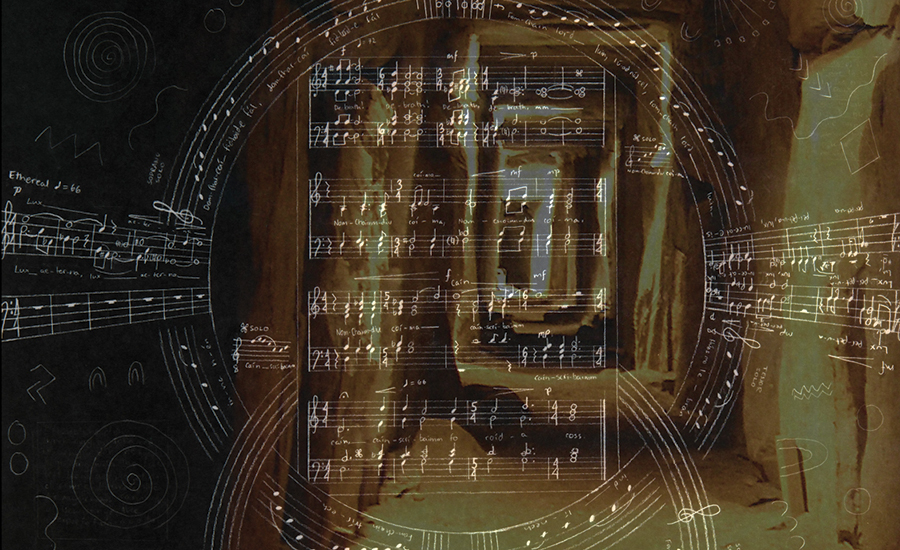
Wesleyan Collegium Musicum: Gealdorcha—Sung Rituals in Celtic Light and Shadow [New Time]
Friday, May 5, 2023 at 6:00pm
Memorial Chapel, 221 High Street, Middletown
FREE!
Wesleyan’s Collegium Musicum, under the direction of Professor of Music Jane Alden, performs a concert with music spanning 900 years by Hildegard of Bingen, Philip the Chancellor, B. de Cluny, John Dunstable, Binchois, John Taverner, Robert White, Thomas Tallis, John Dowland, Robert Ramsey, Arvo Pärt, and a new work by Grace O’Duffy.
Just as the influence of Irish pilgrims extended to continental Europe and beyond, Wesleyan’s Collegium Musicum sing their way back through centuries of cathedrals, chapels, and hermit cells, into an ancient necropolis constructed 5,000 years ago. Silent footprints of musical activity are evoked in stone carvings, along with the movement of stars and planets. This program explores the influence of the “harmony of the spheres” on medieval and Renaissance vocal polyphony, with complementary choral works from modern composers. Pythagoras and his school of mystical mathematicians discovered the relationship between length, ratio, and musical tones. Because numbers and geometrical shapes were seen as the eternal structure behind all reality, Pythagoreans believed the planets—spaced at perfect distances—rotated in serene, eternal motion to create a musical harmony of the heavens. All of this was taken up by Plato, Aristotle, and classical astronomy and incorporated into various pre-modern cultures. Some corroboration was found with the invention of the radio telescope, which suggested that stars, galaxies, novae, and quasars all vibrate with living energy. Thus, we can still see a universal geometry governing the movements of the planets. Many Irish engraved stones were carved with what seem to be solar and lunar symbols.
In spite of the spread of Gregorian chant, Irish psalmody and hymnody remained distinctly Celtic in the early Middle Ages and “adapted” the old Irish pre-Christian melodies. The sun, moon, and stars were incorporated into Christian worship, providing a reminder of the cyclical nature of the universe. This was particularly important in monastic communities that sung together, even while out in the fields at work. Their day was also punctuated by periods of silence, or thoughtful engagement. The Divine Office moves through the hours of night and day, calling together the faithful to pray. This encourages a deeper awareness of the hours of the day not simply as time passing but as an entering into the depths of the eternal nature of the Divine. The monastic understanding of “hour” relates to the Greek hora: a soul measure. The beauty of the Liturgy of the Hours offers perspective on our hurried lives, and an opportunity to retune ourselves to the music of the heavenly spheres and to look again on our world with renewed hope, as darkness, twilight, and light come and go.
Under the direction of Professor of Music, and Professor and Chair of the Medieval Studies Program Jane Alden, the Wesleyan Collegium Musicum will perform pieces that provide a musical introduction to the relationship of music to light and darkness. The Irish term “gealdorcha” is used instead of the more usual Italian “chiaroscuro” as a theme. Featured works will include Hildegard, "Columba Aspexit (A dove gazed in through a latticed window)," "O Nobilissima Viriditas (O Most Noble Greenness)" (12th century); Anon. (Aquitanian polyphonic versus), "Veri solis radis" (12th century); Anon. or Philip the Chancellor, "Sol eclypsim patitur "(late 12th/early 13th-century); Philip the Chancellor, "Sol oritur in sidere" (13th century); Anon. motet, "Apollinis eclipsatur / Zodiacum signis / In omnem terram" (14th century); Dunstaple, "Quam pulchra es" (15th century); Thomas Tallis "Te lucis ante terminum" (16th century); John Dowland, "In darkness let me dwell" (17th century); Robert Ramsey, "Sleep, fleshly birth" (17th century); works by Arvo Pärt, and a new commission from a young Irish student.
RELATED PERFORMANCES
Pop-up: Monday, May 8 at 1pm in Olin Library
Concert: May 8 at 1:30pm, at Wasch Center, 51 Lawn Avenue
Composite image (detail): Score for LUX ÆTERNA by Grace O’Duffy; Brú na Bóinne complex, Ireland (photo by Przemysław Sakrajda, Wikimedia Commons).